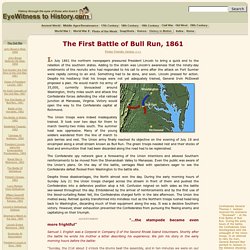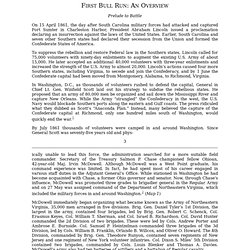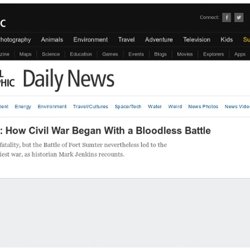

The First Battle of Bull Run, 1861. The First Battle of Bull Run, 1861 In July 1861 the northern newspapers pressured President Lincoln to bring a quick end to the rebellion of the southern states.

Adding to the strain was Lincoln's awareness that the ninety-day enlistments of the recruits who had responded to his call to arms after the attack on Fort Sumter were rapidly coming to an end. Something had to be done, and soon. Lincoln pressed for action. Despite his hesitancy that his troops were not yet adequately trained, General Irvin McDowell proposed a plan. March his army of 35,000, currently bivouacked around Washington, thirty miles south and attack the Confederate forces defending the vital railroad junction at Manassas, Virginia. The Union troops were indeed inadequately trained. The Confederate spy network gave a forewaring of the Union intentions and allowed Southern reinforcements to be moved from the Shenandoah Valley to Manassas. Despite these disadvantages, the North almost won the day. Samuel J.
First Bull Run: An Overview. Prelude to Battle On 15 April 1861, the day after South Carolina military forces had attacked and captured Fort Sumter in Charleston Harbor, President Abraham Lincoln issued a proclamation declaring an insurrection against the laws of the United States.

Earlier, South Carolina and seven other Southern states had declared their secession from the Union and formed the Confederate States of America. To suppress the rebellion and restore Federal law in the Southern states, Lincoln called for 75,000 volunteers with ninety-day enlistments to augment the existing U.S. Army of about 15,000. He later accepted an additional 40,000 volunteers with three-year enlistments and increased the strength of the U.S. By July 1861 thousands of volunteers were camped in and around Washington.
McDowell immediately began organizing what became known as the Army of Northeastern Virginia, 35,000 men arranged in five divisions. Map 1 if necessary, going to the support of Brig. Map 2. Interactive CIvil War Map. The Battle of Fort Sumter. During the winter of 1860-61, the citizens of Charleston (map) , South Carolina , were so sure that no war would follow their recent move to secede from the United States of America that the fiery editor of the supposedly vowed to eat the bodies of all who might be slain as a result.

Not to be outdone, former U.S. Senator James Chesnut, Jr., promised to drink any blood spilled. After all, "a lady's thimble," as a common saying had it, "will hold all the blood that will be shed. " Perhaps the most visible reminder to Charlestonians of the U.S. government's dominion over them was in their harbor, where atop the lonely bulk of Fort Sumter the Stars and Stripes still flew ( pictures of Fort Sumter before and during the Civil War ).
The November election of the notably antislavery Abraham Lincoln as President of the United States had so angered seven slave-owning states that they had chosen to secede and form their own union. (See magazine's top ten U.S. Or had it? Fort Sumter Animated Map.